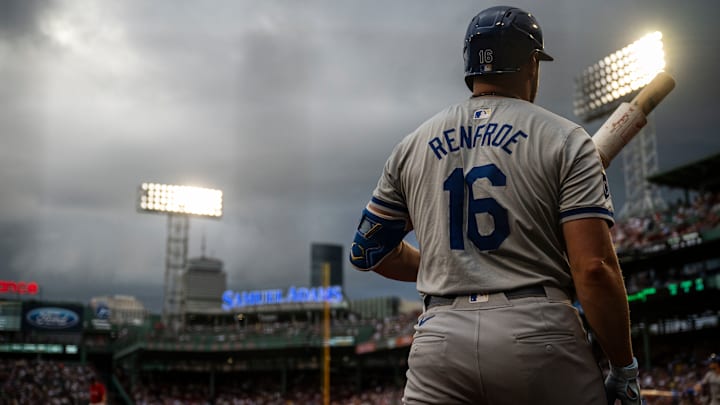Some free agent deals succeed spectacularly. Others, though, like these entered into by the Kansas City Royals, turn out badly. No major league club can predict with certainty how any deals will fare ... but each and every one of them can weigh, and ultimately steer away from, a certain contract provision that increases their risk as soon as it's proposed by either side.
The player option. Case in point: the Royals and the free agent deal they struck with Hunter Renfroe a couple of years ago. Hindsight is, as they say, 20/20, but the sweetness of Renfroe's contract is all on his side of the fence.
Contract danger faced the KC Royals when they signed Hunter Renfroe
Kansas City had long needed upgrades to its outfielders' offense when the club secured Renfroe's services two Decembers ago, and Renfroe's major league résumé suggested he could help fill the void. Then an eight-season big league veteran, his 11-game debut in 2016 and the pandemic-shortened 2020 campaign represented the only two seasons he'd hit fewer than 20 homers. His defense was certainly questionable, but his power potential was a selling point the Royals apparently couldn't resist.
Included in Renfroe's deal, however, and as reported at the time by MLB.com Royals beat writer Anne Rogers (and currently reflected in KC contract details at Cot's Baseball Contracts) was a provision granting him a player option for the 2025 season. Simply put, it gave Renfroe the right to opt in to playing for the Royals this season.
In other words, and regardless of how well or badly he performed for Kansas City in 2024, it gave Renfroe a deal guaranteed for two years, with the second season entirely within his control. He could, without having to overcome the obstacle of negotiating for a second go-around with the club, merely exercise his option for another year — and at a locked-in salary of $7.5 million.
And exercise that dangerous-for-the-club option is precisely what Renfroe did, and who could blame him? The move gave him a nice $2 million raise over the $5.5 million he'd made for hitting 15 homers but slashing a weak .229/.297/.392 for the Royals in 2024.
And while picking up his option certainly favored Renfroe, how has it worked out for his employer? Not well. A hitless, 0-for-3 effort against the Astros Saturday night, followed by a 1-for-2 performance against them Sunday, left Renfroe with abysmal numbers — he's slashing .177/.257/.210 , hasn't homered since late last season, and all but two of his 11 hits across 70 plate appearances have been singles.
The line between underperformance and non-performance is a fine one, and Renfroe is dangerously close to crossing it if he hasn't already.
So, is the point here that the blame for Renfroe's disappointing and distressing lack of production rests with his contract, and specifically the 2025 player option it includes? Of course not — it's not the document that hits or fails to hit. But that option handcuffed the Royals, leaving them no way to avoid rostering Renfroe for the 2025 campaign without trading or releasing him. The former alternative probably wouldn't have netted much, and the club wasn't about to eat $7.5 million without at least giving Renfroe another chance.
And that, in a nutshell, is the danger inherent in the player option. Yes, it's an incentive teams offer to convince players to sign and players eagerly seek, but at the same time it obligates clubs to extra seasons they might not otherwise give disappointing players. The one-sided leverage is with the player, not the club.
Will the Royals, or any other teams for that matter, ever cease agreeing to contracts with player options? Probably not. But the dangers remain clear.
